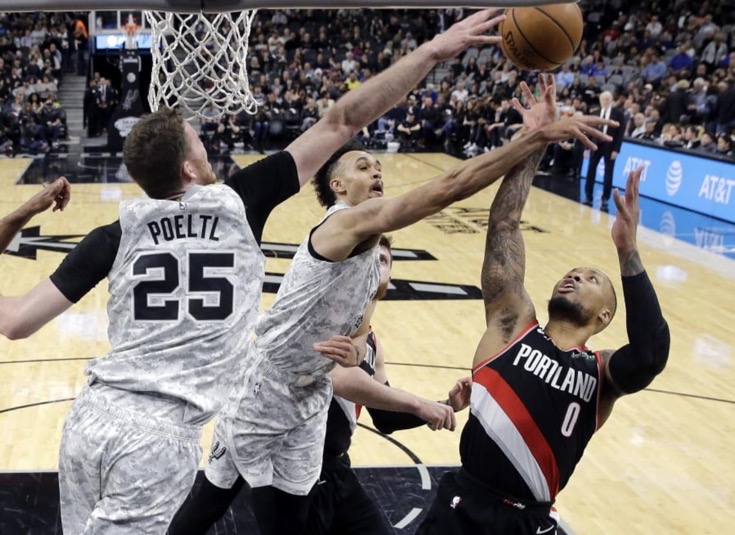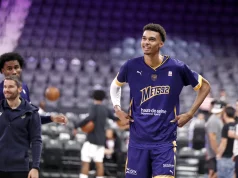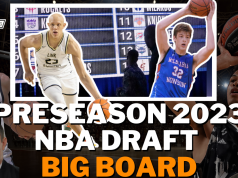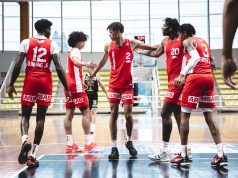Last week, we examined the growth of Dejounte Murray, Chimezie Metu, and Lonnie Walker IV and discussed some possible areas of improvement as this season winds down. Here, we complete our look at the young members of the Spurs rotation.
Note: The young players analyzed here are those 25 years old or younger and who have played at least 15 games this season.
This week: Jakob Poeltl, Trey Lyles, Derrick White
Last week: Lonnie Walker IV, Chimezie Metu, Dejounte Murray
Jakob Poeltl / 24 / Restricted Free Agent this Summer
A few weeks ago I wrote about Poeltl’s solid performance and potential on both ends of the floor and how he may fit into the Spurs’ future plans. While he is still firmly in a backup role to LaMarcus Aldridge, he has impressed as a defensive difference-maker and a smart team player on offense.
Even if Poeltl doesn’t develop an outside shot, his screen-and-roll ability on offense and excellent defensive rim protection should be enough to make him a viable starting center. However, he hasn’t had the opportunity to regularly prove himself against opponent starting centers, leaving a bit of uncertainty. He did stand up well against Rudy Gobert when the Spurs beat the Jazz without Aldridge, but regular starting opportunities are unlikely with Aldridge’s contract guaranteed for this year and next. If the playoffs slip out of reach, a few games of rest for Aldridge might allow Poeltl to test himself against the opponent’s best players.
When that opportunity comes, one area Jakob needs to improve is in defensive rebounding. The ugly start to the Rodeo Road Trip saw the Spurs squander winnable games by giving up second-chance points.
Despite his size and general defensive IQ, the Spurs’ rebounding has suffered when Poeltl is on the floor. Opponents grab 27.1% of offensive boards when he plays vs. 23.6% when he is off.
Often high-volume shot-blockers like Poeltl give up boards because they leave their man to contest the shot attempt. As Poeltl gains experience, he will improve his feel for when to help and when to stay at home. Given his intelligent positioning and reading of the game as a rim protector, Spurs fans can be optimistic he will develop as a rebounder as well.
Trey Lyles / 24 / Under Contract until 2021 (‘20-’21 non-guaranteed)
The acquisition of Trey Lyles brought mixed-to-negative feelings from Spurs fans. For starters, he wasn’t Davis Bertans, and he wasn’t Marcus Morris. On the floor, it was not clear where his value to the team would be.
However, in just a few months Lyles has grown into a versatile two-way player. For now, his contributions are inconsistent but at his best, he offers a tantalizing combination: 3-point range with the skills to attack closeouts, and the ability to defend multiple positions.
Can Lyles Develop into a True Multi-Positional Stopper?
When drafted by the Jazz in 2015, Lyles promised to merge solid rebounding and rim protection with the capability to switch onto multiple positions. This potential largely failed to materialize in Utah and Denver, but his switching skills have finally been more evident in recent months.
This year, he has allowed a very good 0.79 points per possession when defending guards – that number was 1.11 points/possession last year. Continuing this trend will make Lyles very valuable to the Spurs. It allows Popovich to put him on opponent scorers in various positions, relieving weaker defenders like Forbes, DeRozan, or Gay of those duties. The Spurs like to switch perimeter actions, and Lyles’ ability to execute those switches or drop back and protect the rim allows Pop to mix-and-match coverages to suit the opposition.
Lyles makes his case for a long-term spot with the Spurs when he makes plays like this:
His defense here is textbook. A low, balanced stance prevents LeBron from exploding past him, while he uses his length to deter a pull-up jump shot. Lyles then moves his feet, staying in front of LeBron without fouling, and stays in position to deny his shot at the rim.
The numbers this year don’t match that impressive clip: Lyles gives up 1.09 points per possession against other forwards. He can be overpowered and isn’t quite quick enough to chase elite shooters around the perimeter. But his improvement covering guards, and flashes like this possession against LeBron shows that he has the tools to be a good to very good multi-positional defender. Applying those tools consistently will make him very valuable to the Spurs, who lack a reliable stopper at the forward positions.
Derrick White / 25 / Under Contract Until 2021 (Extension-eligible this summer)
Derrick White already has a strong all-around game with no major weaknesses. White can score at all three levels (from 3, mid-range, and at the rim). He is already flirting with elite status running pick-and-roll: his 1.03 points/per possession is in the 89th percentile of ball handlers running pick-and-roll. He is a strong defender on the perimeter and one of the best guards at challenging shots at the rim:
There is some uncertainty over White’s ability to maintain this level as a starting point guard. Strong performances this year and last year during Murray’s injury absences, and some very good games against Denver in the playoffs, suggest that he may be ready for that step. On the other hand, Denver’s adjustments to shut him down and win the playoff series point to his weaknesses against defenses that are well prepared for him. While he can do most things well, he lacks one elite offensive skill that can take apart defenses on its own.
Defensive Intensity
The Spurs’ future prospects could significantly improve if White makes the leap from a good defender to a game-changing one – the type of defender that causes opponents to rethink gameplans and play calls. Look how Patty Mills, an inherently limited defender due to his size, uses his tenacity and anticipation to blow up the Heat’s attempted handoff action:
If White consistently brought that kind of aggression along with his 6’4” height and 6’7” wingspan, offenses could have nightmares simply getting into their sets. If multiple Spurs defended that aggressively for entire possessions, not just when guarding the ball handler, the team would force the kinds of turnovers and bad shots that their championship-winning and 60+ win teams did.
Steals and blocks don’t tell the whole story, but opponents’ turnover rates this year actually increase from 12.6% to 13.6% when White leaves the court. His Defensive Box Plus-Minus (quantifying the points a team gains by a players’ defensive contribution) is down from 1.1 last year to -0.6 this year (numbers are per 100 possessions).
White’s defensive skill and physicality have been clearly evident since last year. If he matches the aggression of fellow point guard Dejounte Murray, he can drastically raise the Spurs’ defensive ceiling and maximize the potential of the Murray-White pairing.
This season has been a dose of reality for historically spoiled Spurs fans, but many are already anticipating a day when the Spurs are fighting for the top playoff seeds rather than the eighth.
All eyes will be on the continued development of these young players. Their growth is essential if that bright future will change from an optimistic dream with no clear timeline to an achievable prize within these players’ primes.







God article, but how you gonna talk about having players 25 and younger but not mention the 23 year old we just gave an extension to last summer
You’ll notice the headline says part 2. He linked part one and mentioned it covered Murray.